November 2017: I first heard of South Sudan when I was in grade school and South Sudan was still part of greater Sudan. I met a refugee from South Sudan at church who fascinated me with tales of war between the tribes of the south and the northern Arabs, how he escaped and was hunted by lions, chased by elephants, robbed in refugee camps in Kenya and finally managed to escape by boat to Europe. South Sudan has always captivated me as one of the last vestiges of wild Africa and when I had a chance to go to visit the Mundari Tribe with a fixer, I found through some contacts I jumped on the opportunity.
About South Sudan
South Sudan is the newest United Nations recognized country in the world, gaining its independence in 2011. Prior to 2011 it was part of greater Sudan. South and North Sudan couldn’t be more different from one another. The north is Muslim, Arabic speaking and the people are culturally very different. In the South, the people are darker skinned and primarily Christian and animistic. The north is mostly desert and is more developed, while the south is more tribal, undeveloped and oil rich. The north in effort to subjugate the South and control its vast oil recourses has waged war for decades. A USA and United Nations brokered peace agreement led to the independence of South Sudan. This didn’t lead to end in war however as skirmishes continue to flare up between the north and South and inter-tribal fighting over control of the government in South Sudan has led to the deaths of thousands of more people.

Map of South Sudan
Planning a trip to South Sudan was not easy. In 2017, there was very little information available on tourism. Given that the majority of the country was embattled in conflict, there just wasn’t any tourism. In my travel circles I knew one intrepid friend who had traveled in South Sudan to visit tribes. So, I coordinated with them to find a fixer to assist me with organizing my trip. I didn’t want to visit the capitol Juba only. I also hoped to visit some of the tribes that live in the countryside but to do so I needed to make sure the area was safe. The tribe that made the most sense to visit and one that looked fascinating from the limited photos that were available on the internet from national Geographic like articles was the Mundari Tribe. The Mundari, a pastoralist tribe, was located 1/2 a day’s drive from Juba and the area where they were located was stable at the time of my visit. Stability in a country like South Sudan is never a guarantee, however. Just 6 months before my visit, war broke out in the capitol and surrounding countryside and several foreigner aid workers were killed and even raped. A power sharing deal was achieved between rival tribes and a fragile peace has returned at least to the capitol and the Mundari lands. For many other parts of South Sudan, war continued to reap terror.
Arrival in South Sudan and Avoiding Government Spies
To get to South Sudan, my friend Richard and I flew on Ethiopian Airlines via Addis Abba. Our trip began on an ominous note when we were at the airport bar in San Diego having a beer and discussing our upcoming South Sudan trip. A British man who was sitting at the bar stool beside us overhead us and turned to me to warn me about visiting South Sudan. In his words, it is open season on Americans in the country. I asked him why and about his experience there and his only reply was, “I have worked over there extensively and that is all I can really discuss about my time in South Sudan, just be careful”.
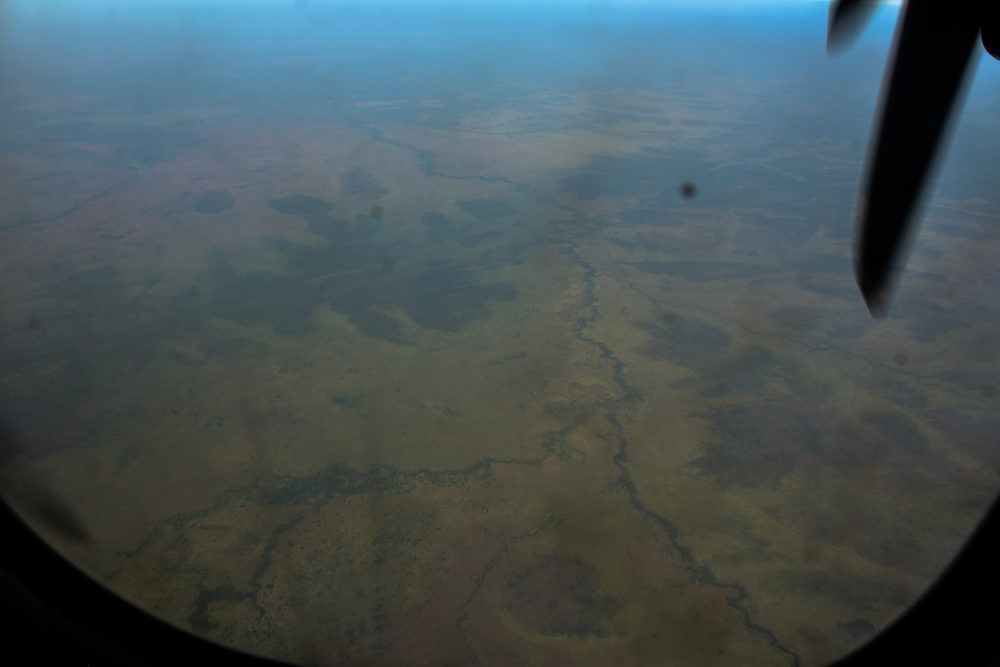
Southeastern South Sudan
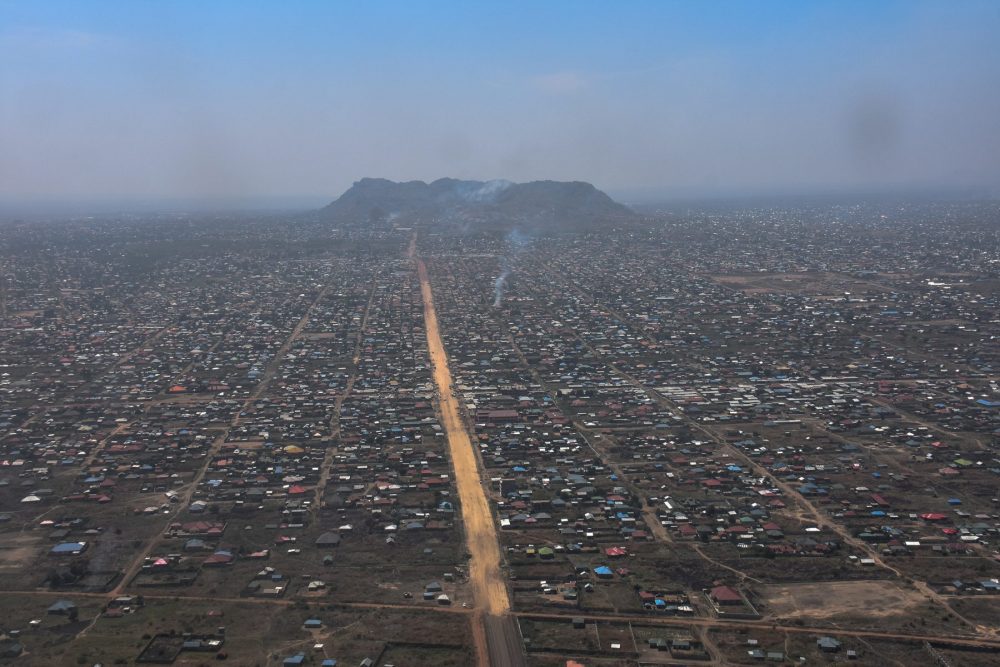
Juba by air
Day 1: Our flight over South Sudan was in a turbo prop plane. After crossing from Ethiopia into southeastern South Sudan, there was nothing but an endless sea of green wilderness-grasslands and scrubland forest. On occasion I could see a small circle of huts. There were no roads in the area and I no towns or infrastructure all the way to Juba. Once we approached Juba I could see the familiar sight of African urban sprawl, a disarray of dirt roads and shanty town and an utter lack of any urban planning. Juba was not a large city, and the airport was under construction and bustling with United Nations planes. We exited the plane and walked across the tarmac into the immigration area, which was under a makeshift tent. The airport seemed chaotic and airport personnel were not friendly.
Our fixer, Donald Champion arranged for a letter of invitation (LOI) for us to obtains visas on arrival (VOA). Strangely, Donald requested I sign all of the LOI’s on behalf of him, which I did. I was worried that VOA process would not go as planned but luckily it did. Once we passed through immigration, we met Donald and driver, Henry and went directly to our hotel-Juba Regency Hotel. There are no western chain hotels in Juba. Our hotel owned and operated by Lebanese was nice, had a pool and a lively social scene of well to do locals around the restaurant/pool area. Evidently our hotel was one the 2nd best in town. My travel companion always generously picks up the tab on hotels initially requested we stay in the #1 hotel in town-the Crown Plaza but Donald and a few other contacts of mine warned me that the hotel was full of government spies that may be suspicious of our arrival and detain us for questioning. Juba was notorious for paranoid police and corruption. A foreigner seen on the street with a camera would result in arrest and the city still reeling from civil war was rife with guns and armed banditry. Our goal while in Juba was to keep a low profile and avoid being noticed by the police or spies so for our first day in country, we stayed in our hotel to recover from jet lag and to prepare ourselves for camping in the bush for the next 3 days with the Mundari Tribe.
At night the window from my hotel room looked out over a neighborhood of pure squalor that existed just on the other side of the fortified walls surrounding our hotel. Armed guards patrolled the walls of our hotel. At times at night, I heard the sounds of errant gun shots. Given that only a few months prior an insurrection occurred in Juba, I had an escape route in mind to the US Embassy of necessary.
Into Mundari Tribal Lands
Day 2: To get to the Mundari tribe, we would need to drive to Terekeka and from there find out the current location of the semi-nomadic Mundari’s. In the morning, we set off on the long 4–5-hour drive to Terekeka, a small town on the Nile River. We traveled in our 4wd Hilux across one of the only highways in the country, a deeply rutted dirt road with potholes that could swallow entire trucks. We passed military checkpoints and even though we weren’t able to obtain our registration papers the day before at the police station because the police chief was out, Donald knew the drill with the police checkpoints and every police checkpoint was the same, after a friendly chat, a few handshakes and most importantly a discreet exchange of money, and we would be allowed to go. We were given a script to respond with when the police would ask us about our plans in South Sudan. Many people in South Sudan did speak English and, in a country, where tourism was a foreign concept and would only arouse suspicion, instead of saying we were tourists we would say we were engineers that came to build water wells. This the police understood and welcomed. The road was wild and there were no villages or vehicles, except for a few U.N. convoys. We drove through wild bush, and I couldn’t help but to think of the possibility of being attacked and robbed by bandits, rebel soldiers or even rogue police officers. In a place like, there were many opportunities for things to go potentially wrong. But so far, I was loving the adventurous country of South Sudan.
When we arrived in Terekeka, we had to go to the police station for a formal meeting with the police chief. This would be our biggest test because we most definitely would be asked many questions about our purpose in the area and there was a possibility, we could be denied entry our even detained. The police chief was an older and intimidating man. We sat in his office with him and a few of his officers while he began with a casual conversation with Donald. The conversation then turned to us and in English the police chief asked us about our plans and our work at home. I did most of the talking on our behalf and again reiterated our plans to build water wells. I kept my SLR camera well-hidden and out of view because this would definitely arouse suspicion. Our story held up and we picked up some more supplies, water and rice in town and were given directions of the whereabouts of the Mundari and we set off into bush tracks that went into the interior. The tracks were mostly overgrown by vegetation in parts and were hard to follow. We were off to find the Mundari.
Who are the Mundari
The Mundari are a semi-nomadic tribe of pastoralist. They are a warrior tribe with a reputation for their fierceness. Most men carry AK-47’s to defend their cattle. Their cows are their livelihood and the center of their existence. Wrestling is the main sport, and the people, well-muscled with an average height among the tallest in the world-on average over 6.1′ are intimidating in appearance. Of all the cultures I have visited in the world, the Mundari are the largest people that I have encountered. The Mundari travel hundreds of miles every year with their long-horned cattle in search of better grazing grounds. During the rainy season they can be found closer to Juba but in dry season they are closer to Terekeka. They have converted to Christianity but practice a hybrid version of Christianity mixed with animistic traditional beliefs.
1st Night with Tribe
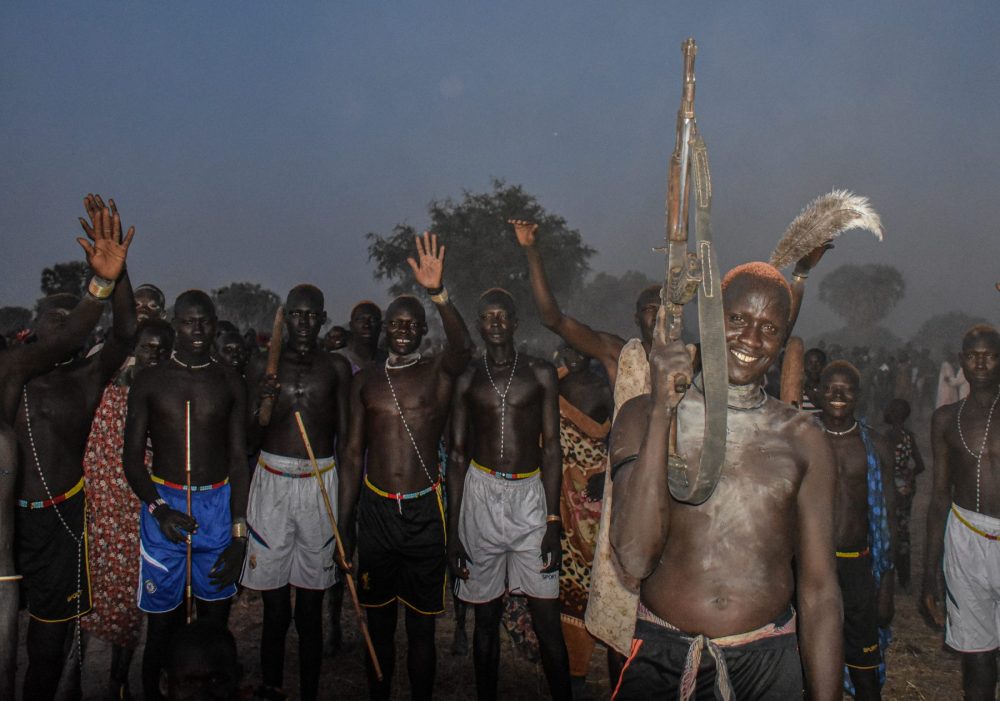
Mundari Party
After a few hours of driving and stopping to ask random Mundari for directions, we finally arrived to a location that appeared to be in the middle of nowhere but according to Donald was where the Mundari were staying. When a 7′ tall naked man, with a chalked face, yellow died hair and armed with a gun walked past, I knew we were someplace truly special. We arrived at a village of scattered huts. It was starting to get dark when we arrived and, in the distance, I could hear the sound of what resembled a north American Indian pow wow. There seemed to be some kind of festival, and I could hear drumming and singing. We quickly hurried off to see what was going on and when we arrived, a group of Mundari maybe 30-40 were jumping in celebration while waving their staffs and shooting their Ak 47’s into the air..some of the gun fire went whizzing too close for comfort over my head. The Mundari once spotting us quickly ran over to dance around us and to greet us with huge smiles. I took a few photos and one by one the Mundari surrounded me with their staffs and guns wanting to have their own photos taken. Some of the Mundari were intoxicated drinking some kind of home brew. At times it was a little intimidating because I didn’t know them or even have a basic understanding of their temperament yet and I didn’t want to do anything to make them angry. After one of the wildest cultural experiences I have ever had, we headed back to our camp to set up our tents in the dark. We never did find out what the celebration was about. Donald thought it was possibly a celebration to mark the end of the rainy season or maybe a wedding.
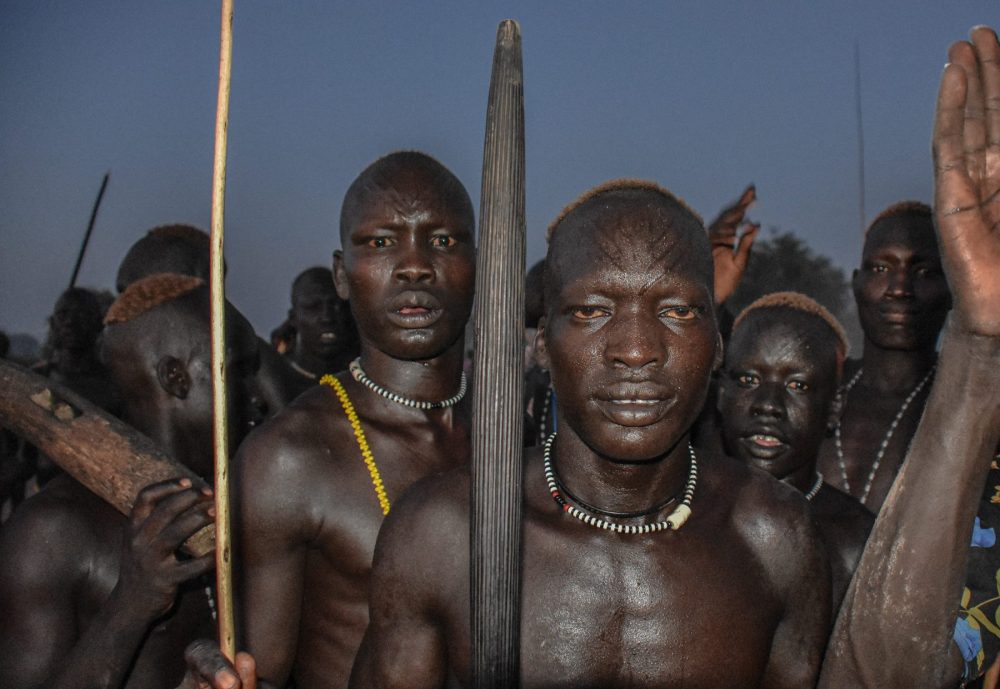
Mundari Party
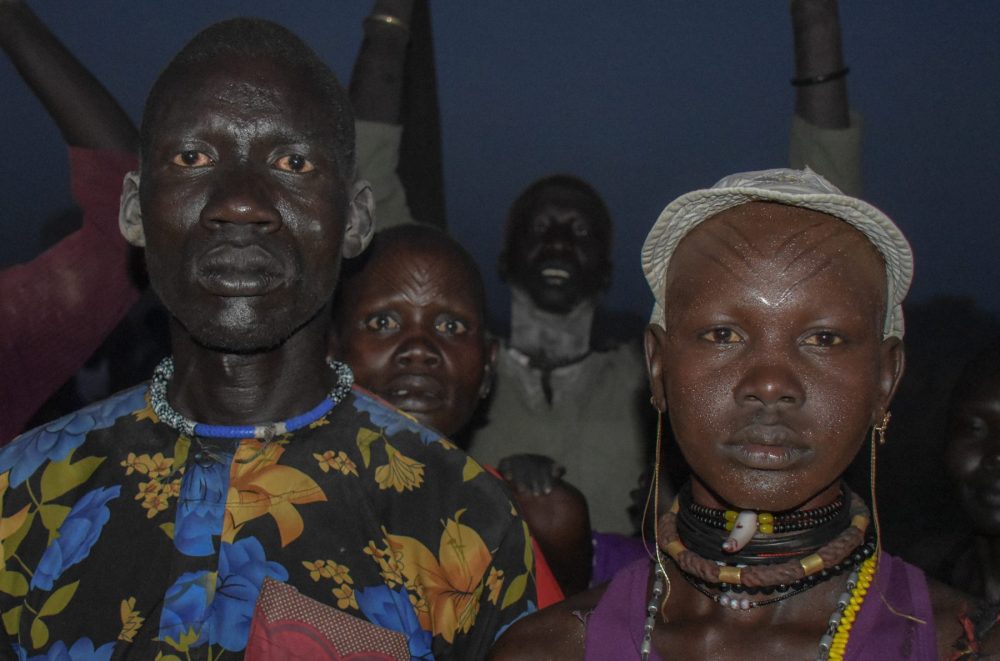
Mundari Party
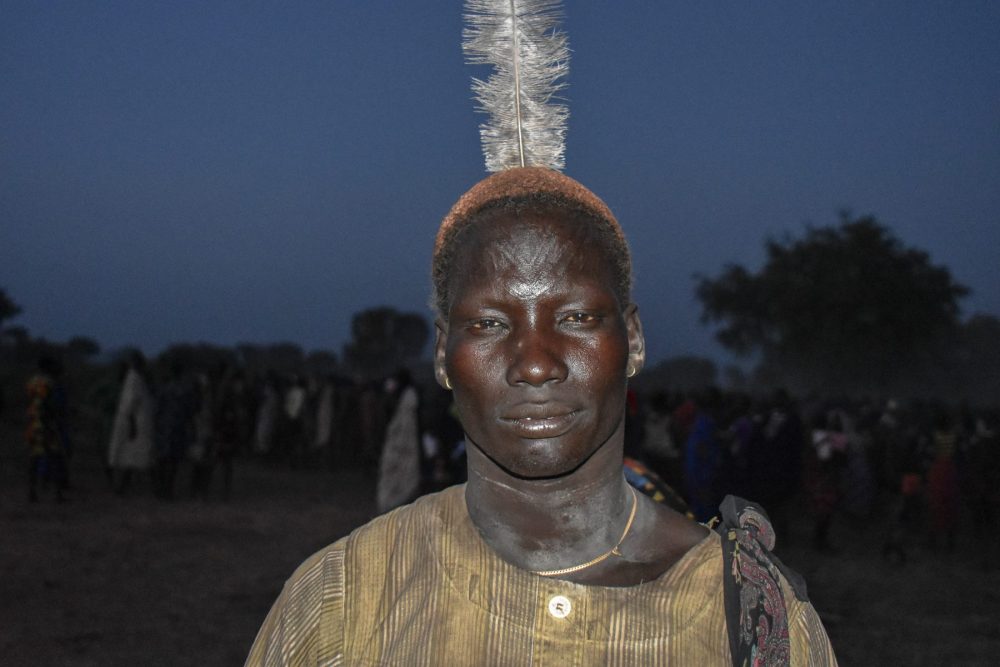
Mundari Party
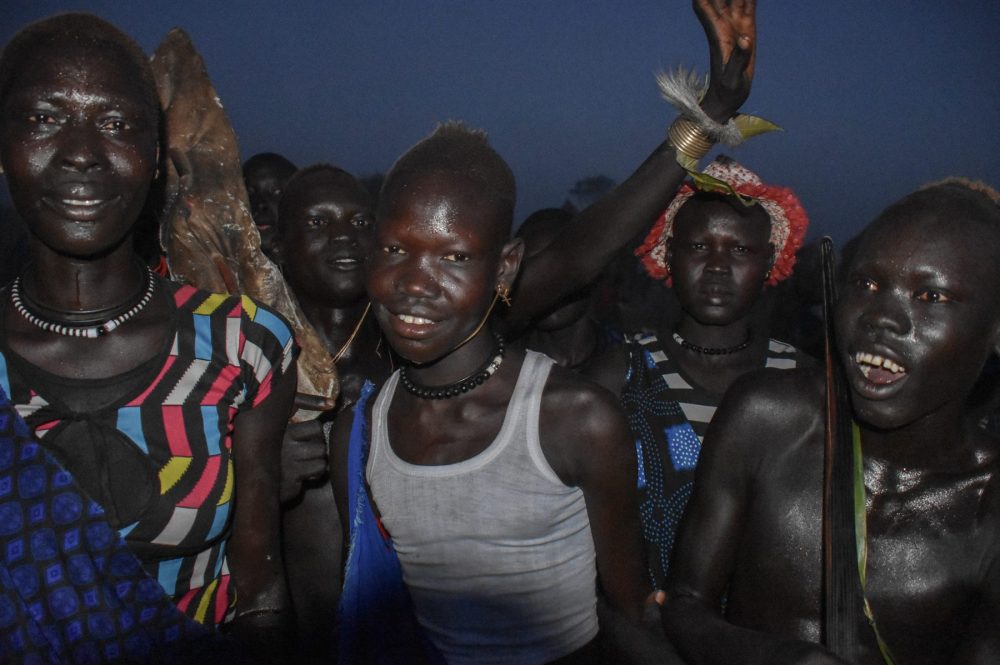
Mundari Party
We cooked pasta and sat outside in the dark eating while the mosquitos and humidity terrorized us. The heat in South Sudan was easily 110 F plus and with tropical humidity. Although the temperature went down at night, the humidity did not. That night I went to bed in my tent while the Mundari continued to celebrate in the distance, and I drifted off to sleep to the sound of African drums, gunfire and singing.
The Mundari Village
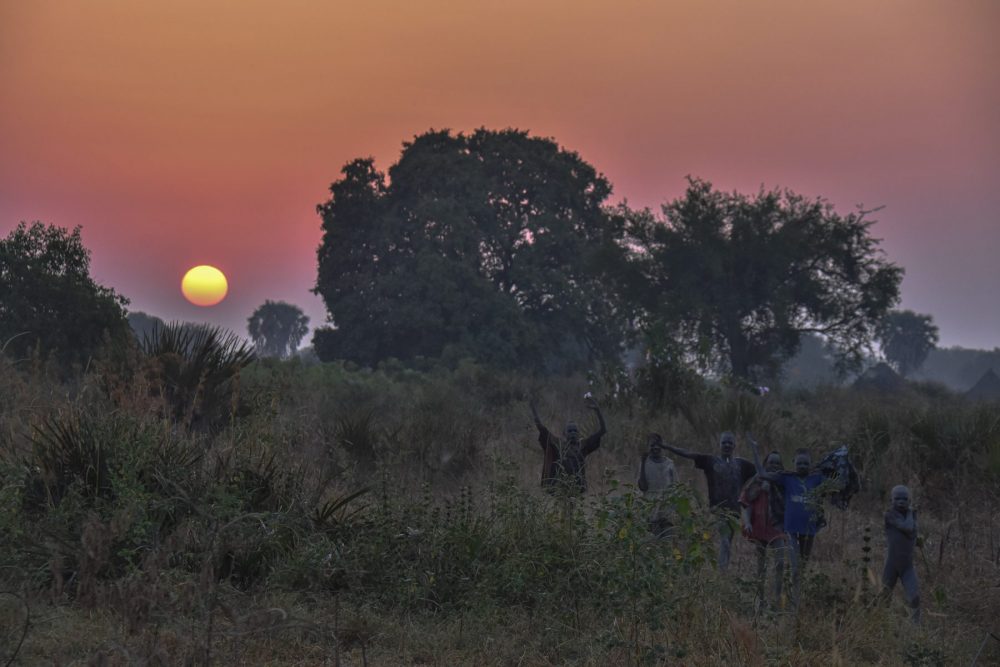
Sunrise
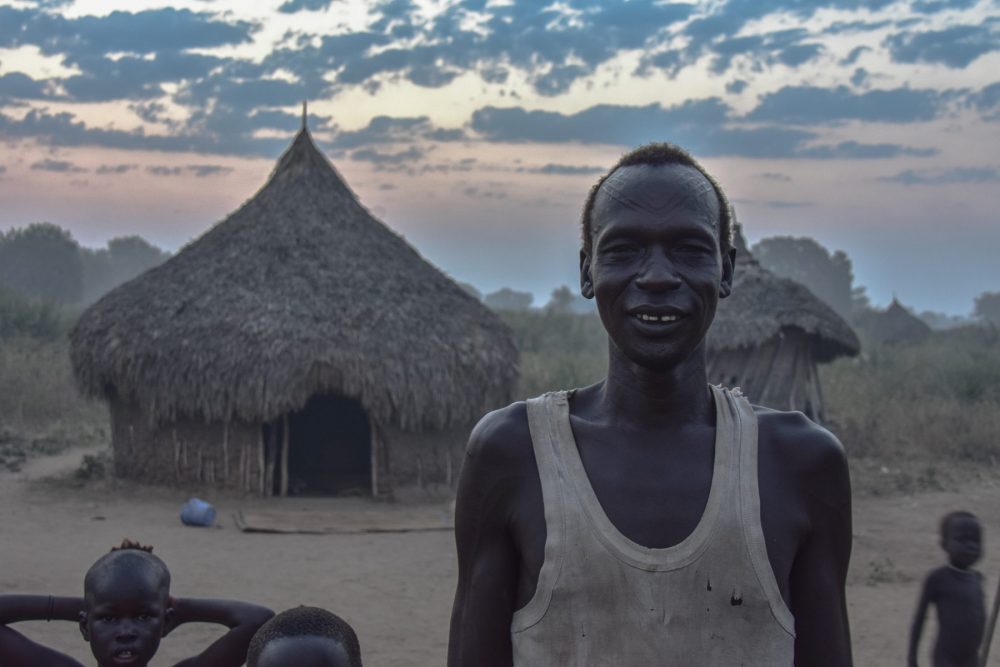
Man in front of his home
In the morning, we awoke to a group of curious Mundari children in our camp watching us. I pulled out my polaroid camera and took some photos that I shared with them. The polaroid photos were a huge hit with the kids. The chief of the camp arrived to greet us, and we shared breakfast with him. Then a middle-aged portly man in a torn and dirty suit, which was completely out of place here, arrived on a motorcycle. I didn’t know who the man was, and he sat down and kindly struck up a conversation in perfect English with us. he asked about our intentions and our jobs, and his conversation quickly seemed to be more of interrogative than friendly. We kept to our story that we were there to build wells. There was some truth to our story since Donald was raising funds to help build wells for the Mundari and we were also donating some money to this fund. But we were not actively building a well. The man’s tone quickly changed to one of anger. he introduced himself as the Minister of Agriculture for the area and claimed it was mandatory to check in with him back in Terekeka. He claimed that that we needed to pay a mandatory fee to him. At that point I removed myself from the conversation and let Donald take over. Donald was an expert in keeping these types of conversations from becoming adversarial. The man and Donald must have worked out an agreement, with an acceptable bribe because the tone of their discussion became friendly. The Minister shook our hands and wished us well and departed on his motorcycle. To think he drove all the way out here from town just to collect a bribe.

Me with a Mundari Man
With the chief of the village, we walked through the huts and people would warmly greet us with strong and long handshakes. The sun had already risen and in the huts, we came across mostly women and children. The men were all off to take the cattle grazing into the countryside. We saw few elderly people; I imagine because the life span of the people is not long. Despite the apparent difficulties of Mundari life, the Mundari appeared happy and proud. There was nothing I observed about them that indicated they were suffering a miserable life of poverty. This was their life, all that they knew, and they were happy with their families and strong sense of culture and community.
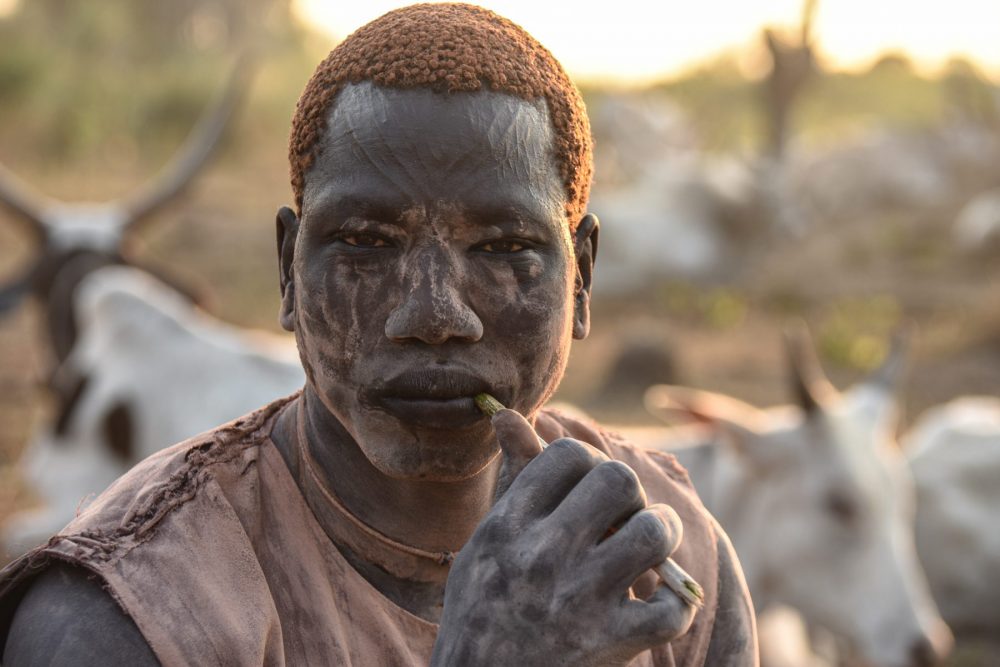
Mundari Man with cow dung on his face and hair dyed yellow with cow urine
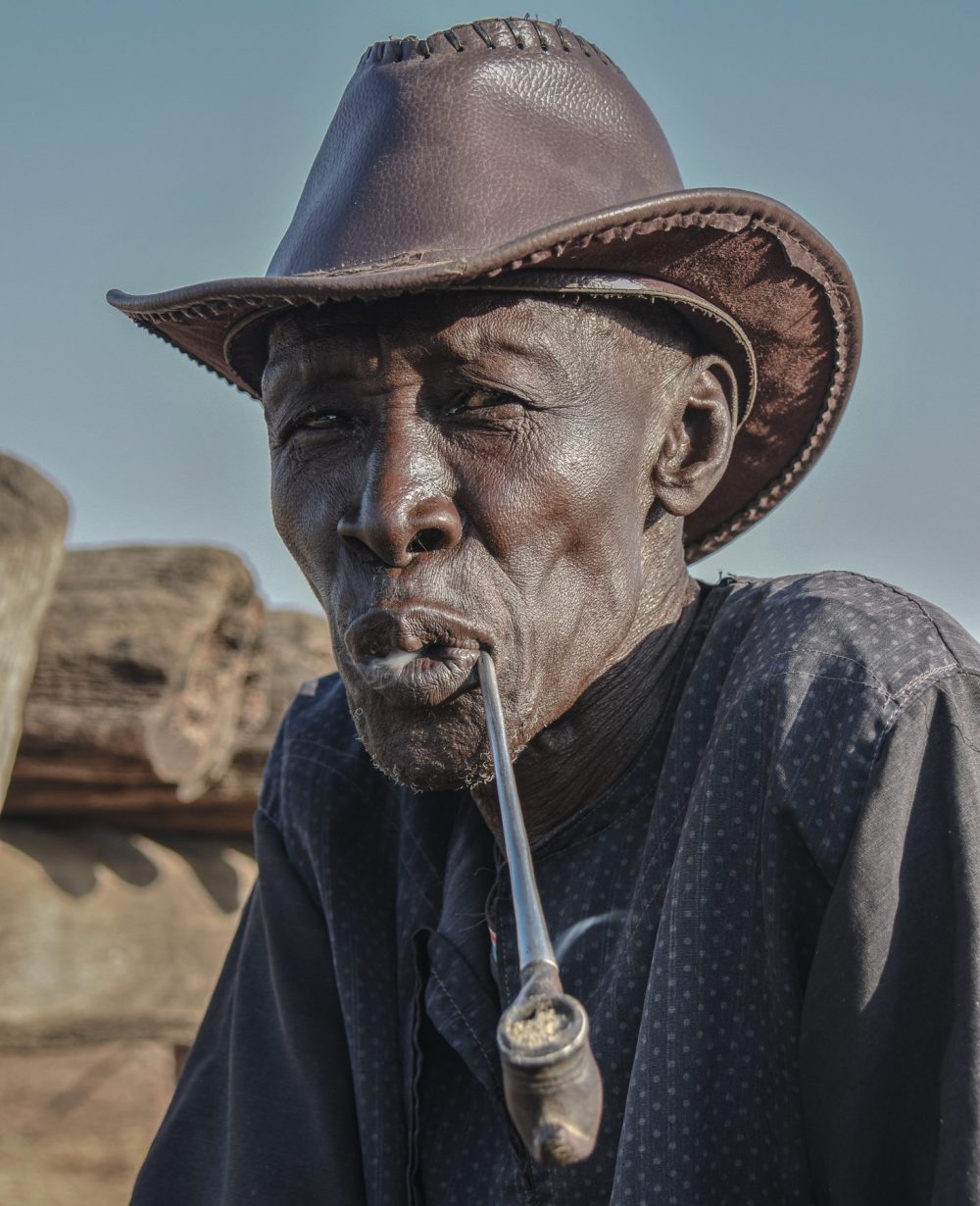
One of the elderly people I observed in camp
Some of the Mundari men I observed were completely naked, but most wore some degree of western clothing. But all had the facial scarification that is a rite of passage for them in their youth both men and women. The men also had a white powder on their face and body looked like baby powder. The powder consisted of cow dung and is used as sun protection and an insect repellent. It was also explained to me that the men put the dung on their bodies to smell like the cows in order to earn their trust. The hair of many of the men is dyed yellow by placing their heads in the urine stream of their cows. The chemical property of the urine causes their hair to become a yellowish color. These practices may seem bizarre, but to the Mundari these are attractive, manly and help strengthen the bond between them and their prized cattle.

Richard showing his photos to a family
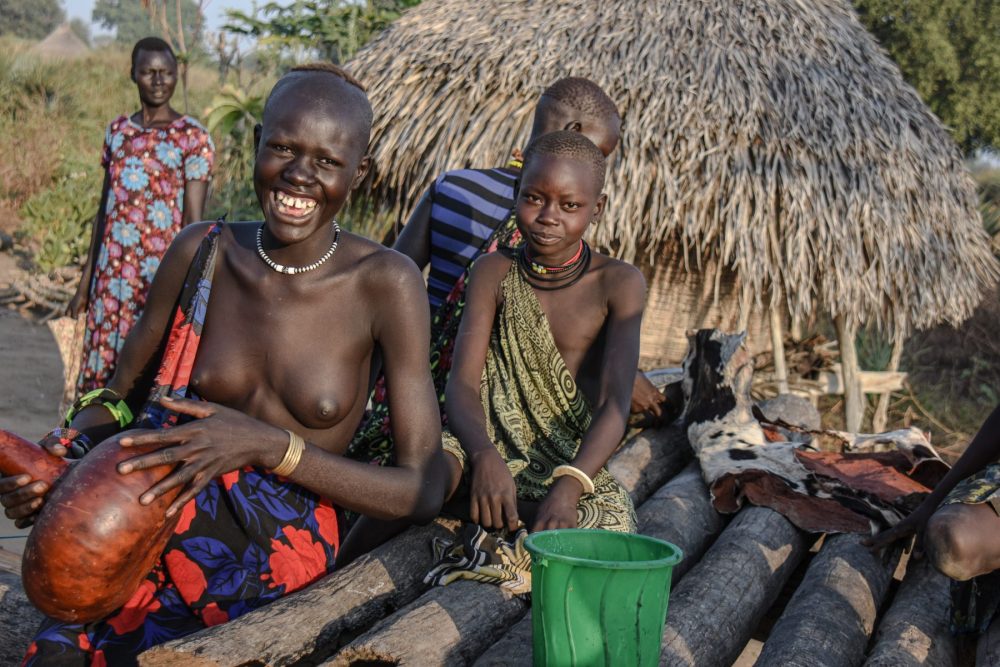
Mundari Family
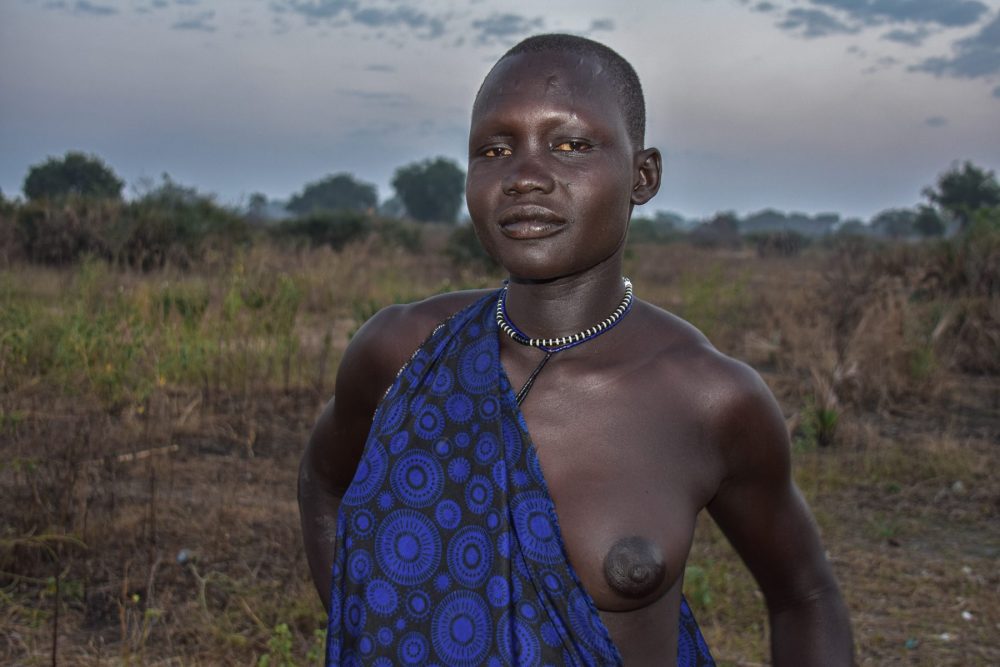
Mundari Woman
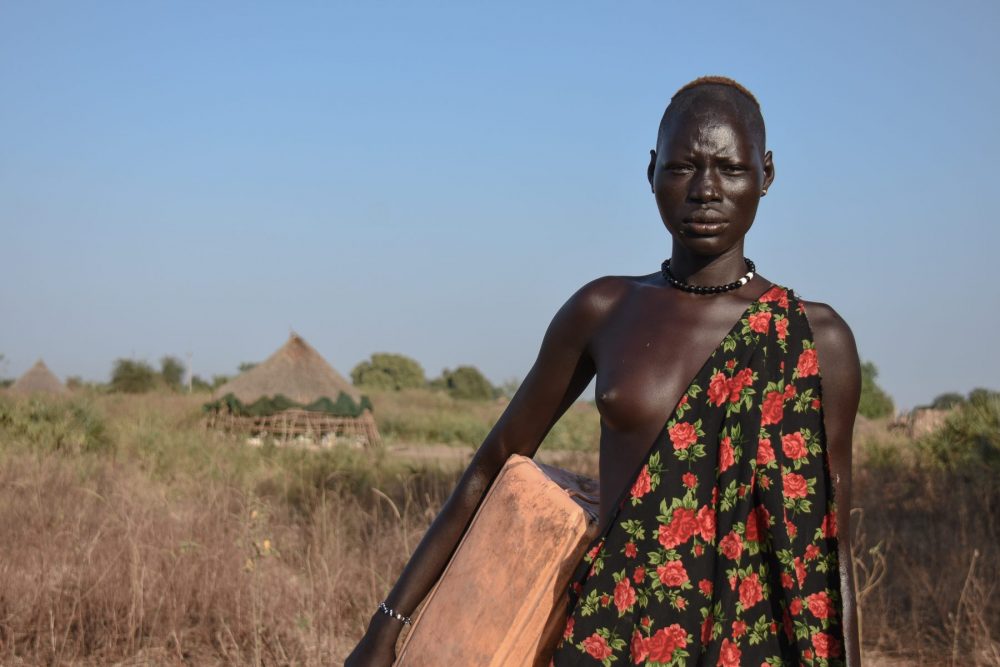
Mundari Woman
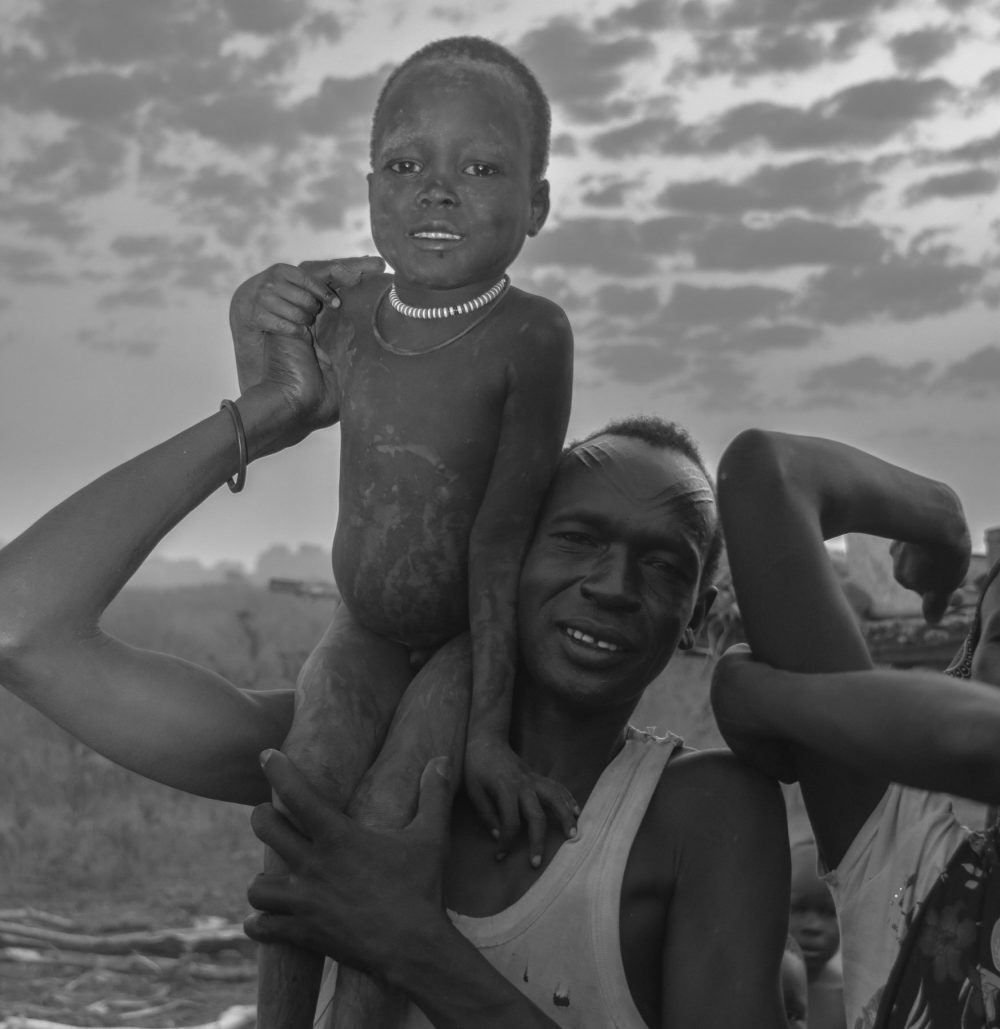
Mundari man proudly showing his child
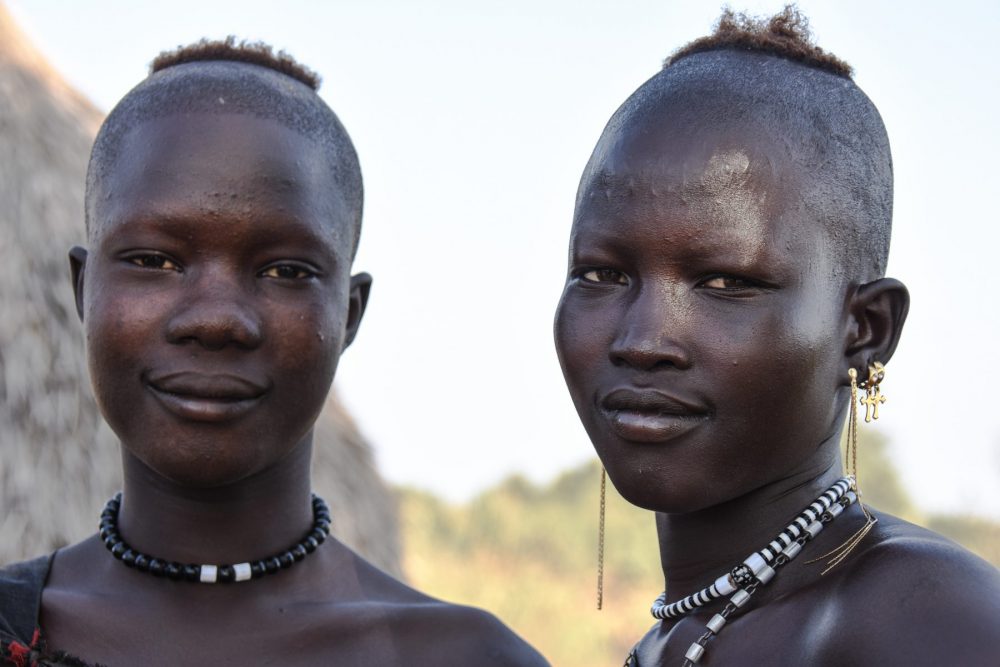
Two flirtatious Mundari Woman who asked for repeated polaroid photos because they didn’t like the way they looked
To prove that people are the same world over even if they are part of a remote, exotic tribe in South Sudan, I took a photo of some teenage girls with my polaroid. When I shared my photo with them, they looked at it and decided they didn’t like their hair or their facial expression and so they asked for another one. After a few repeated takes, they finally arrived at a photo they were pleased with.
Cattle Camp
Day 3: The highlight of any trip to visit the Mundari is a cattle camp, where the cows are kept at night near the village. The men and young boys sleep in the cattle camp to protect the cows. The cattle are the center of the Mundari’s universe. Cattle are not only family, but they are also currency, and they are the pride of the culture. The cows represent a family’s wealth and are given as dowry for a bride. The Mundari rarely eat their own cows. Instead, cows are used for milk, cheese and yogurt. Only when a cow becomes old, is it sold to the market for meat.
Like the people, the cattle are tall and beautiful. To see the cattle camp when there are cattle and people in camp, you need to visit either very early or late in the day before the camp are led out to graze.
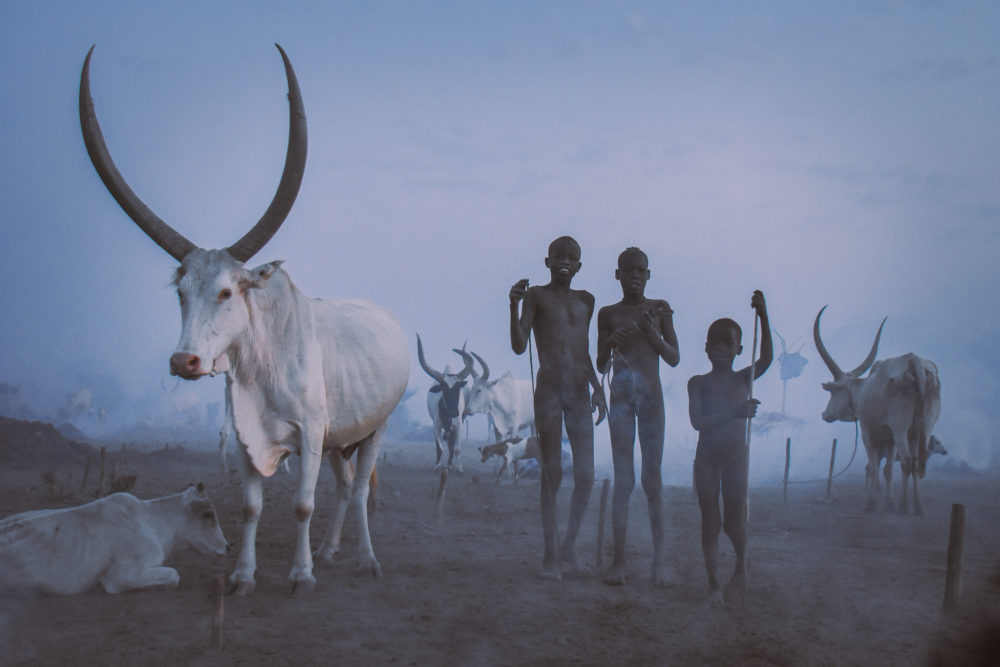
Cattle Camp
There are no women in cattle camps. The camps are full of men and boys. And most are naked. Clothes are thought to scare the cattle. There is little vegetation and lots of small fires. The smoke is believed to deter flies and mosquitos from the cattle and the men massage their cows with the ash to heal their wounds and to furtherly protect them from insects since the ash is believed to deter insects too.
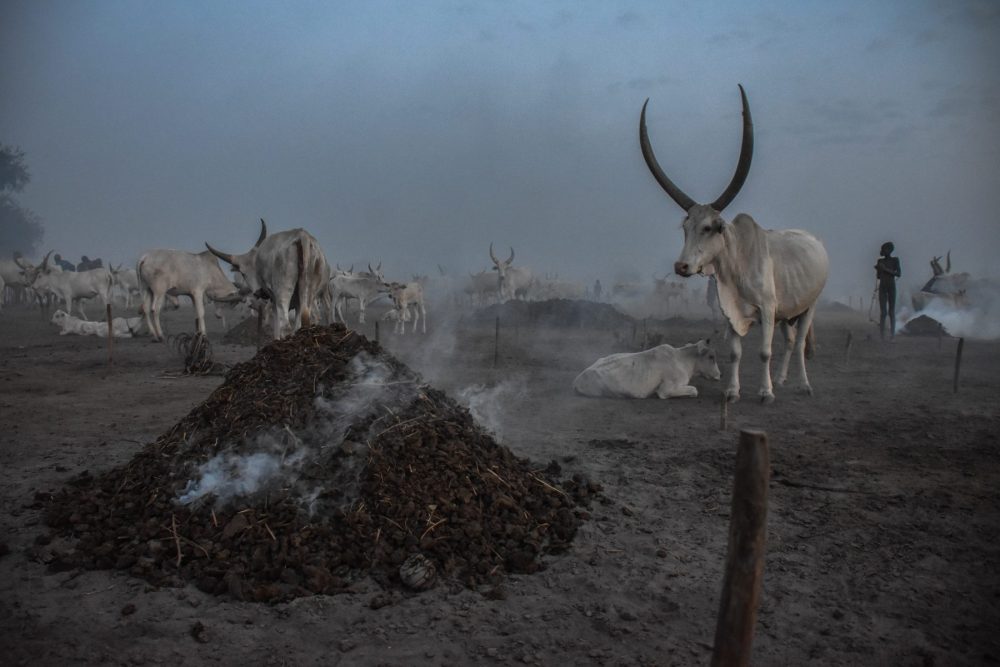
Burning cow dung to create smoke as an insect repellant
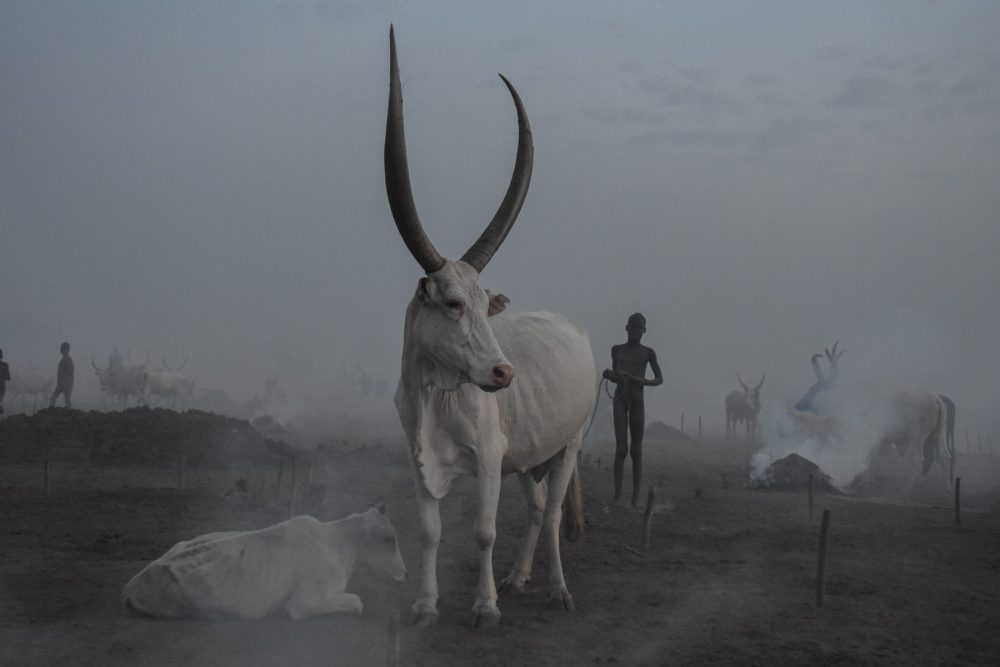
Cattle Camp
The cattle are massive, and their huge sharp horns are intimidating and so I gave them the respect they deserved. Mundari that I photographed would always pose proudly with their favorite cattle. Sometimes in the photo they would hold their arms up to symbolize the horns of the cattle.
Visiting the cattle camp in early morning, with the mix of grey smoke, early morning hue along with the rows of massive cows and Mundari warriors beside them is one of my travel highlights. It is impossible to take a bad photo in the cattle camp and these are some of my all-time favorites so I am just going to post a bunch here.

Cattle Camp

Naked Boy in Cattle Camp

Cattle Camp
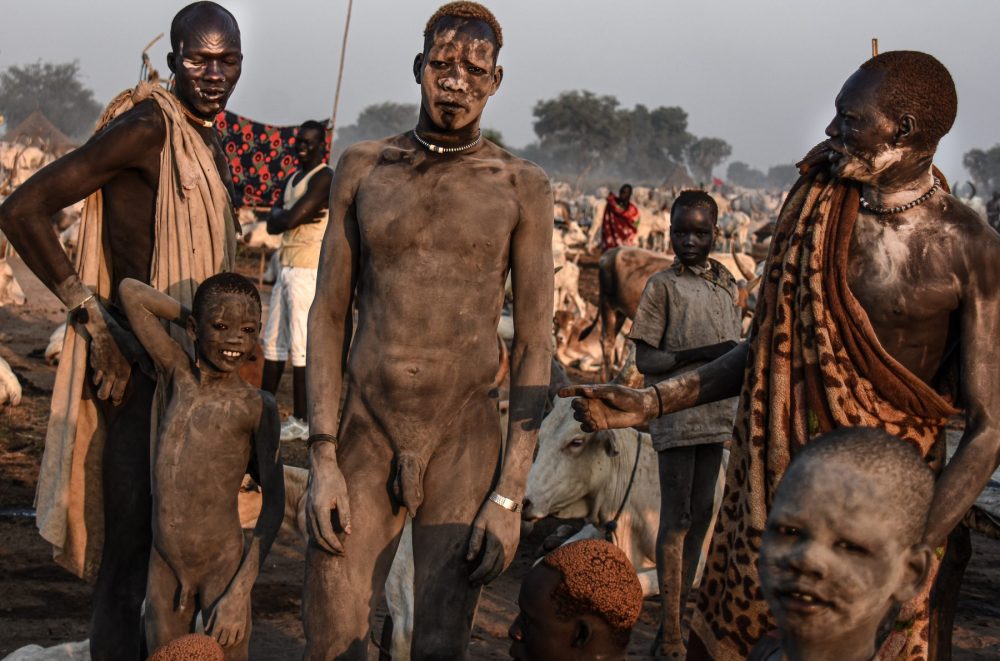
Cattle Camp
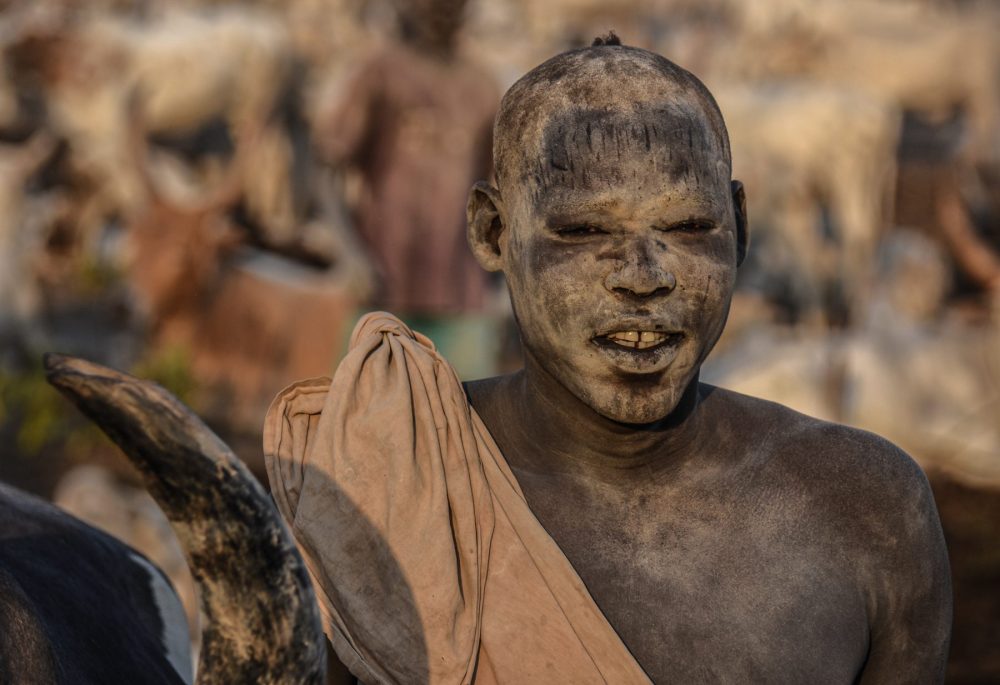
Cattle Camp
One curious practice that i didn’t witness bit i heard is common is for the young boys to put their mouth on a cow’s vagina and blow air into it. For cows that are not with calf’s, this practice is believed to stimulate milk production.
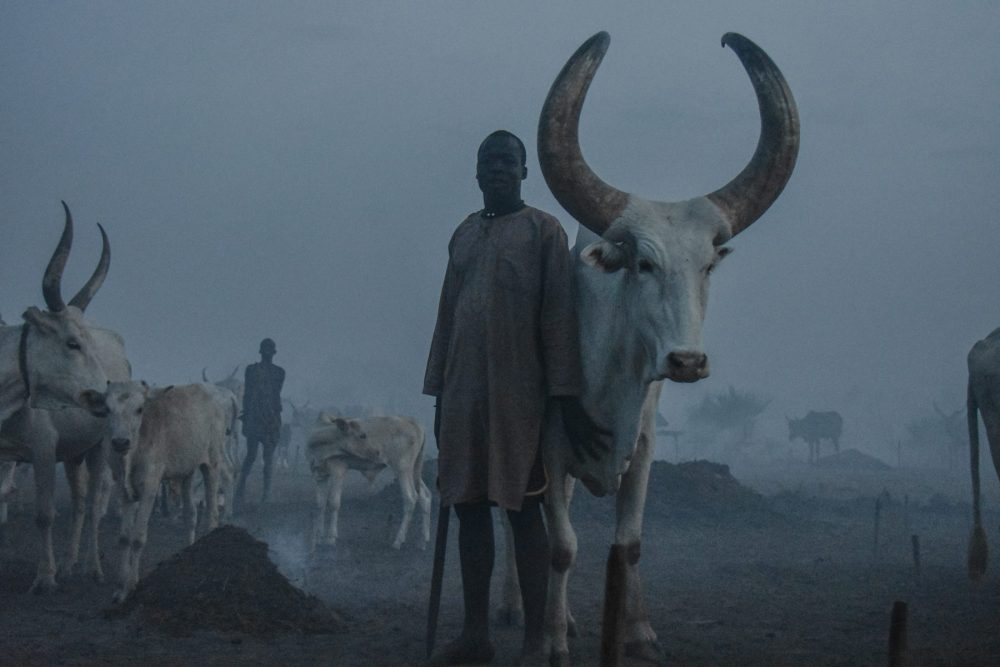
Cattle Camp
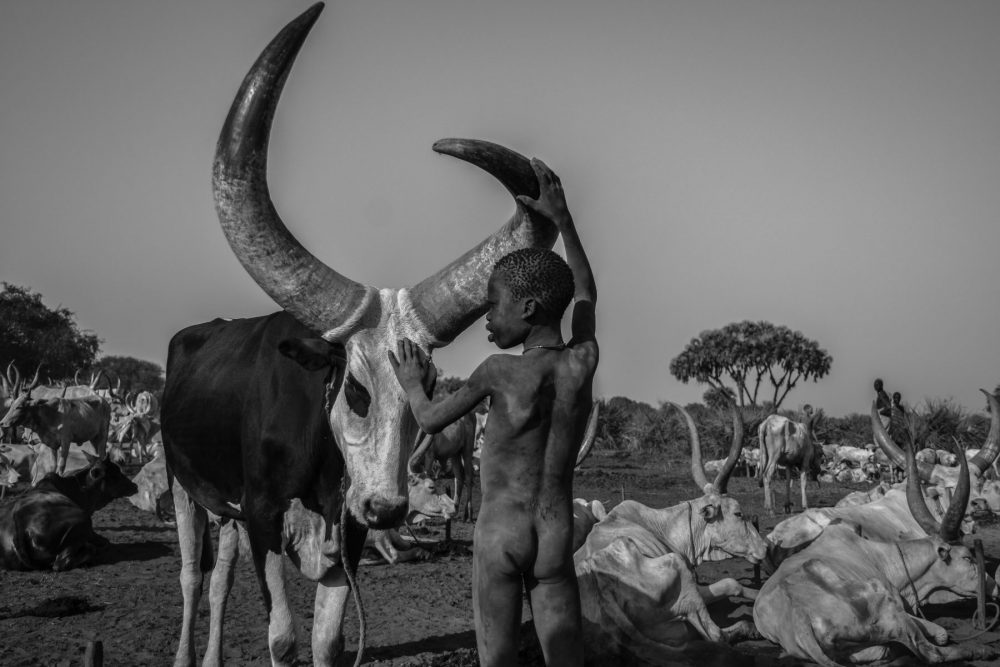
Cattle Camp
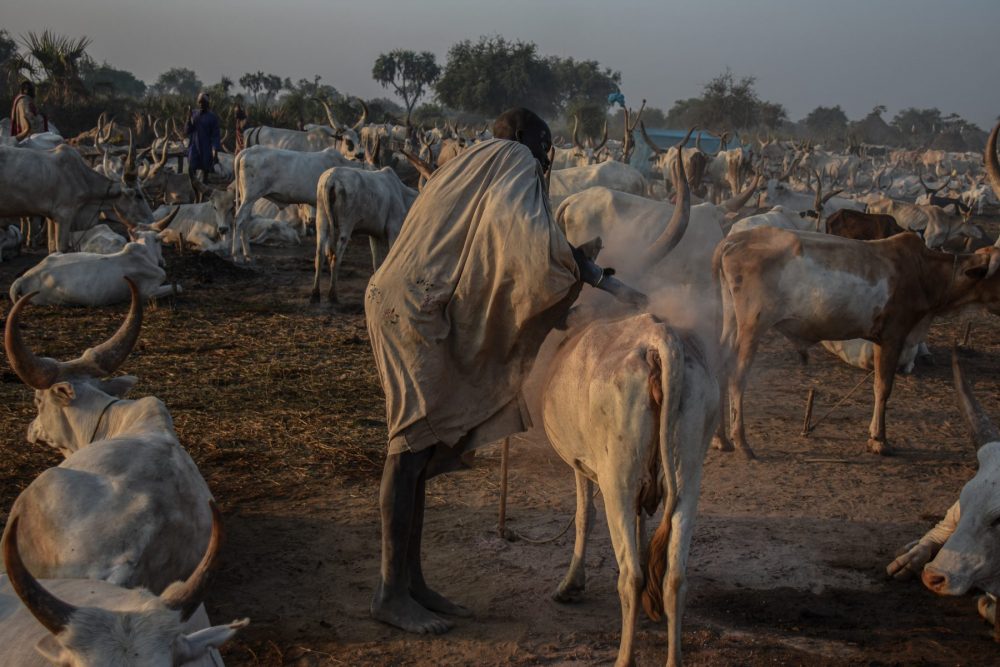
Cattle Camp
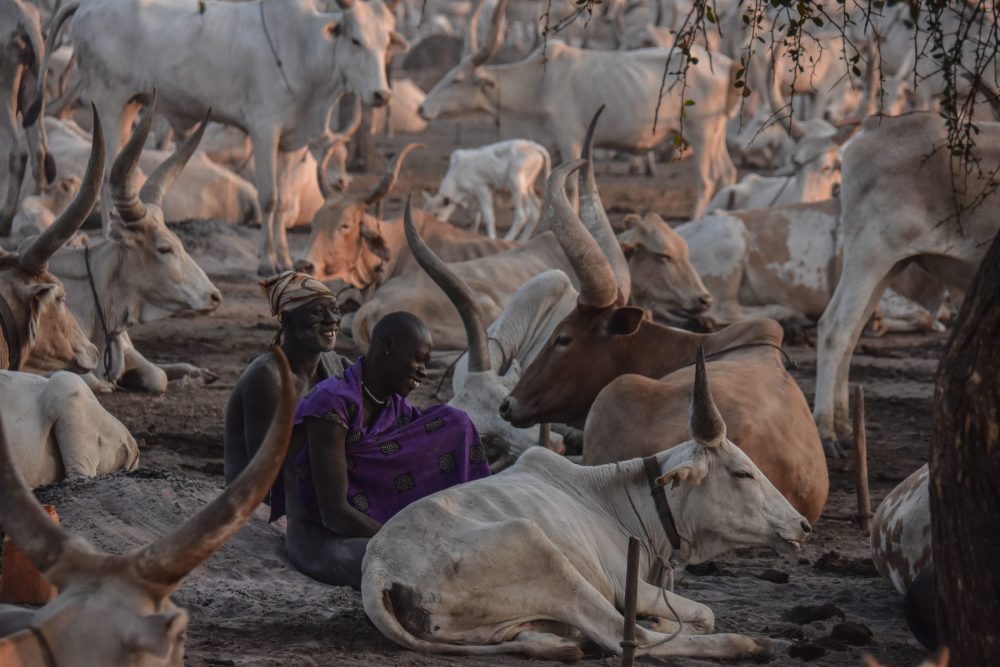
Cattle Camp
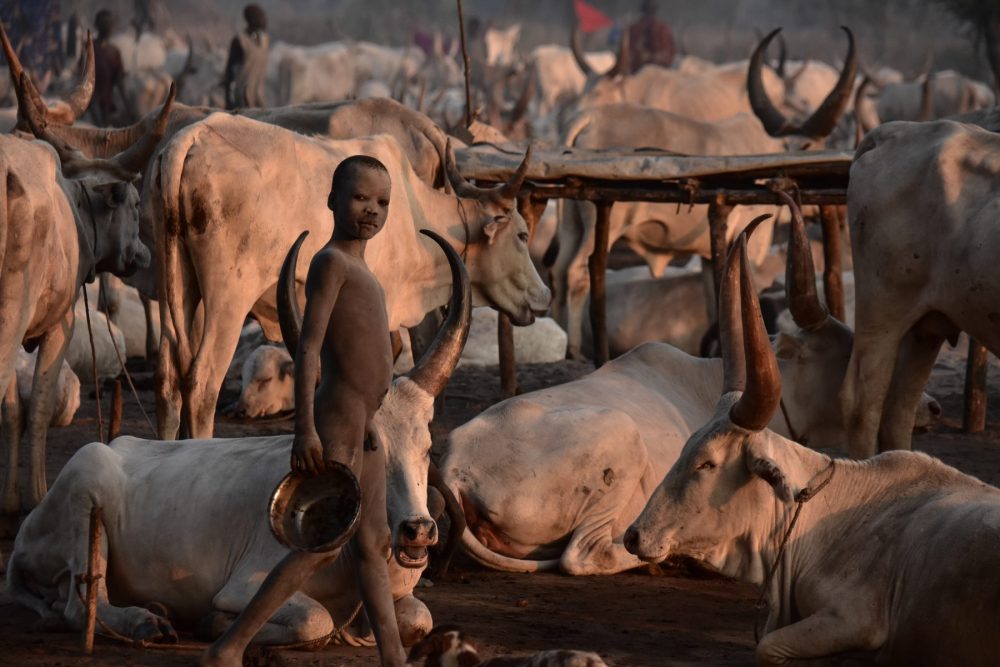
Cattle Camp
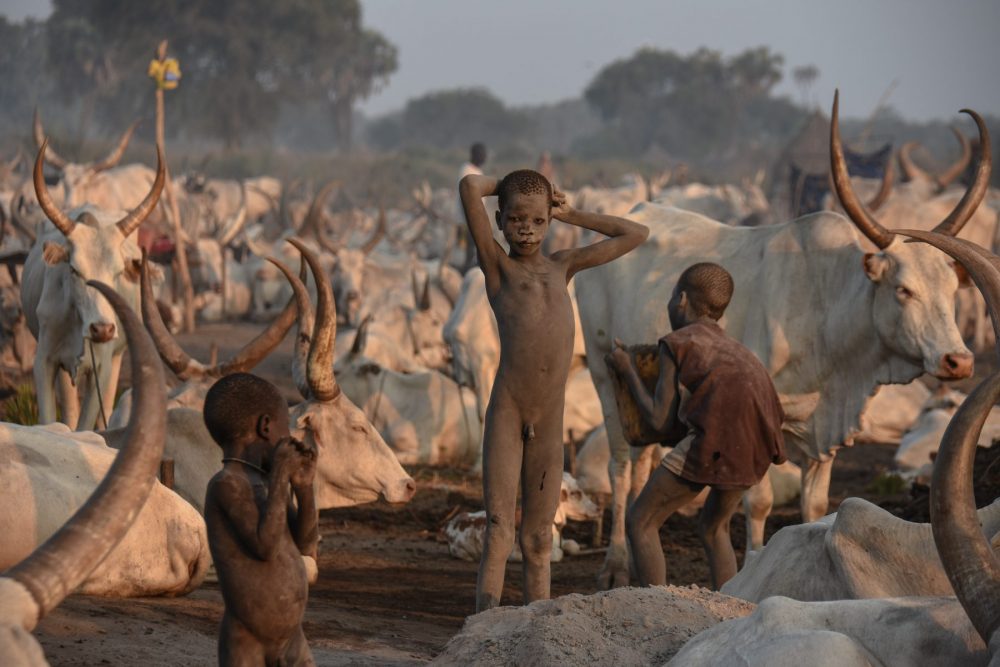
Cattle Camp

Mundari Boy at Cattle Camp with Cow Dung on his Face
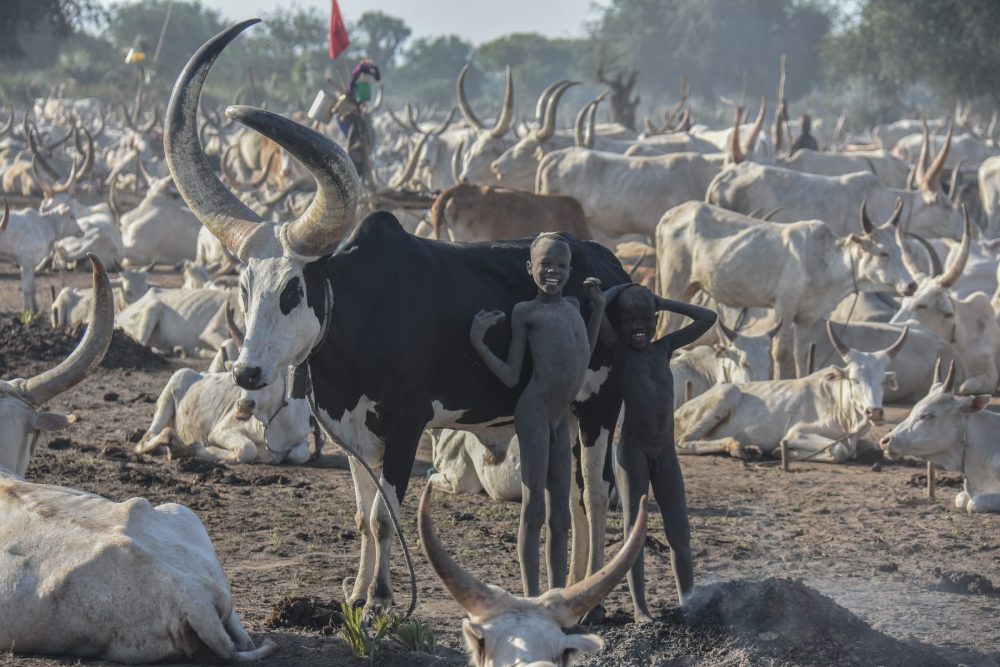
Mundari Boy Tending to His Cattle
The Wrestling Match that Nearly Broke Out into a Gun Battle
The temperatures in South Sudan never cooled. They went from hot and swampy at night to unbearable during the day. During mid-day all we could do was find shade and suffer through the heat with a book and lots of water. The heat didn’t seem to bother the Mundari at all. In the afternoon around 1pm-peak heat of the daytime-we received word that different clans were holding a wrestling match a few miles away. Despite the heat, we had to see this and since there was no road, we had to walk. We arrived at a treeless dust bowl with hundreds of people-men, women and children Mundari spectators-many with AK47s gathered around two enormously built men covered in white dung ash and adorned with a leopard cloth around their waste. A man with a giant staff refereed that match as the two men took turns throwing each other to the ground. The men fought to a constant drumbeat rhythm and women ululated a kind of loud yodeling.
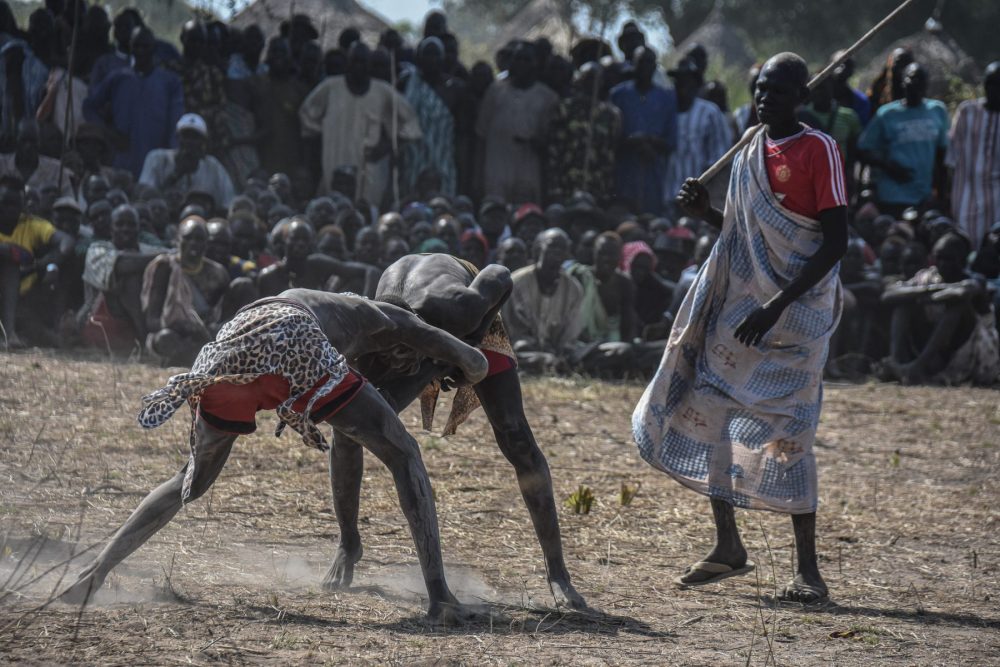
Wrestling match
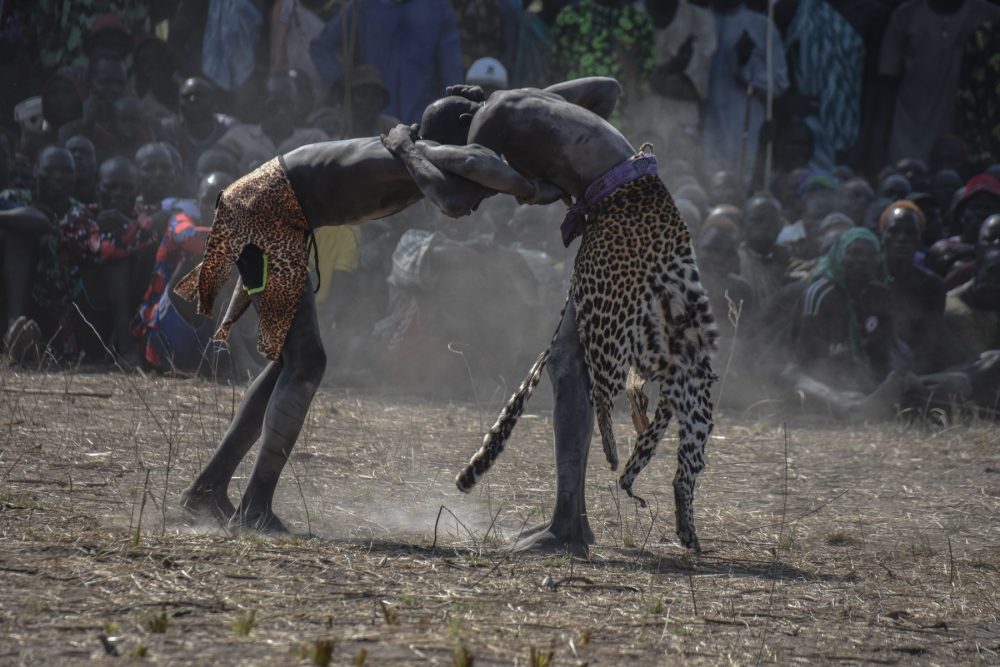
Wrestling match
The Mundari are divided into different clans and many of them fight with another and even steal cattle and kill each other. The wrestling is a traditional way for men from clans from all over to come, represent their clan, blow off steam while proving their manhood. When we arrived, the spectators and fighters all turned to us. The fighters stopped mid-fight and came to greet us, and I took a few photos of them. Most people seemed thrilled to have their photos taken but soon we were reprimanded by the referee who demanded the fighters return to their match and even some of the spectators started shouting at us. One man came up behind me and pushed me. Careful not create a riot that I knew would not end well for us, I walked away, and we stayed out of the way of the fight. At one point one of the fighters challenged me to a fight in the ring. The monster of a man brimming with muscle looked would have destroyed me, so I politely declined.
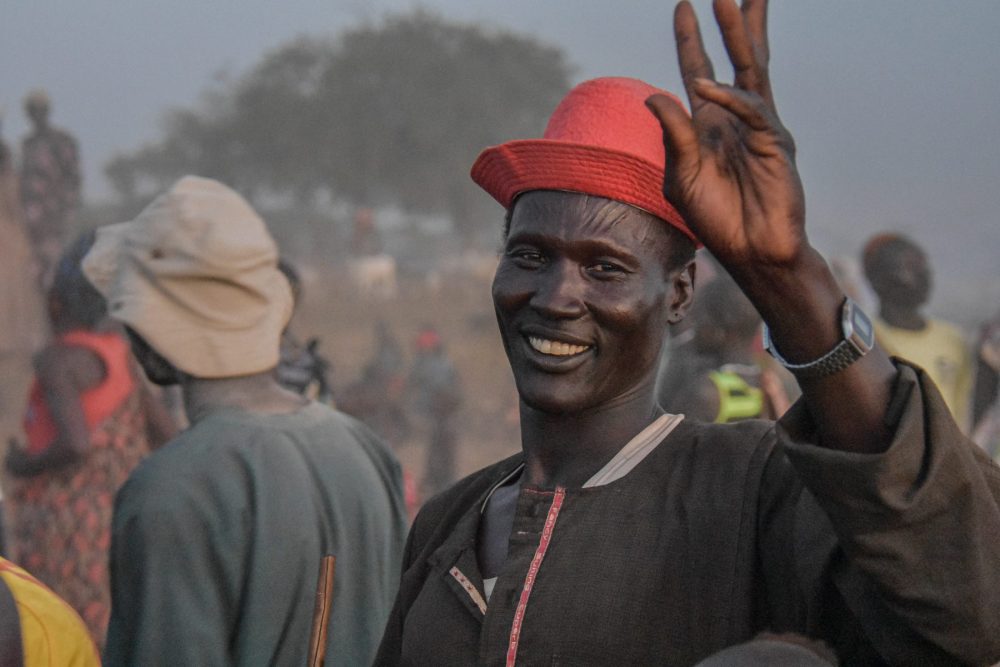
Friendly spectator who asked that I take a photo of him
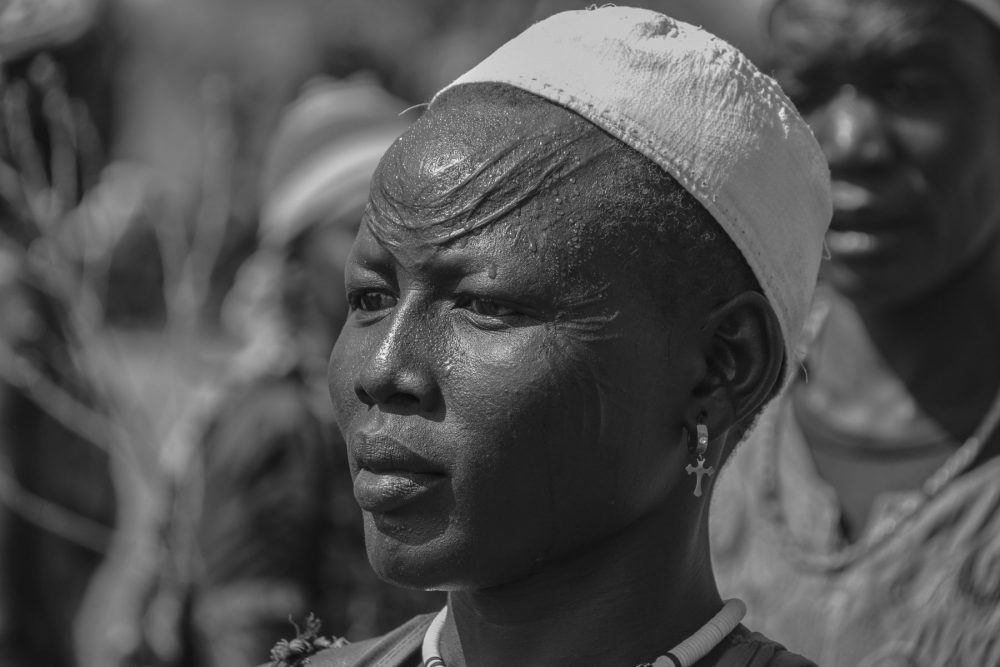
female spectator with traditional tribal scarification on her forehead
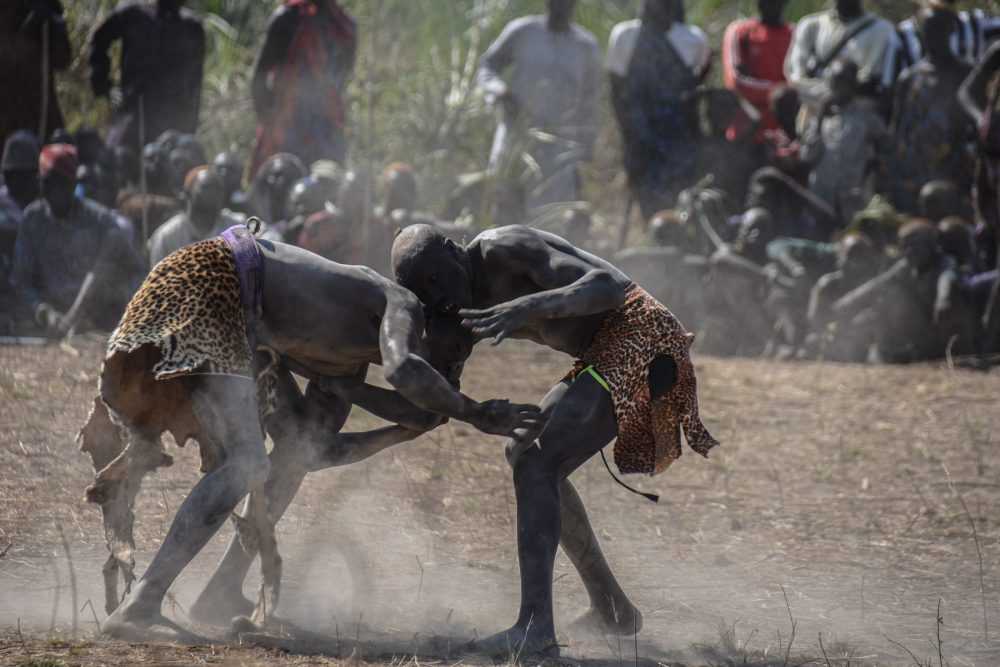
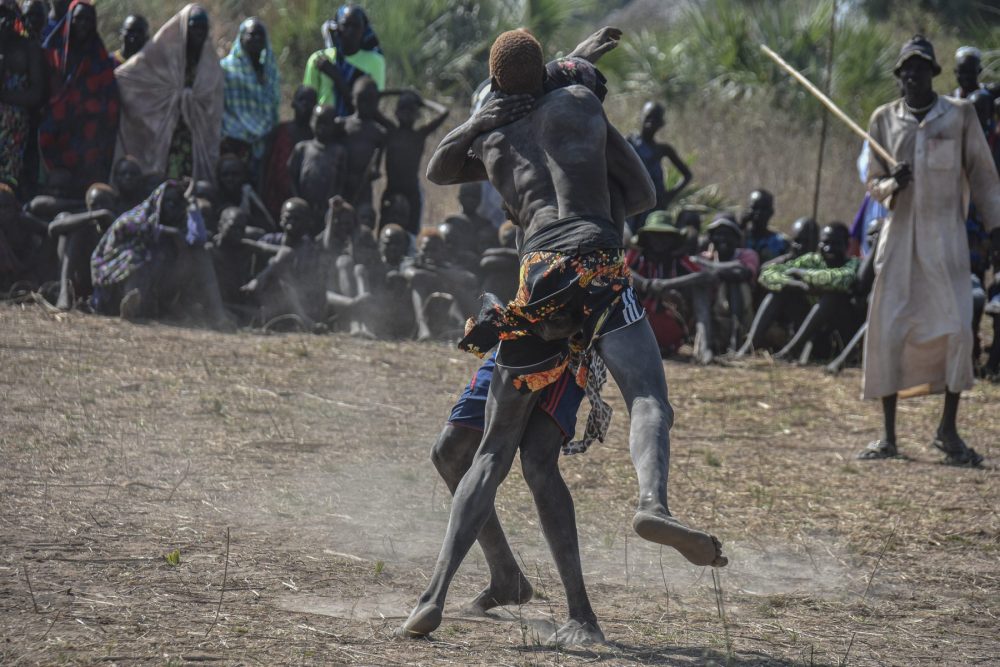
Final takedown
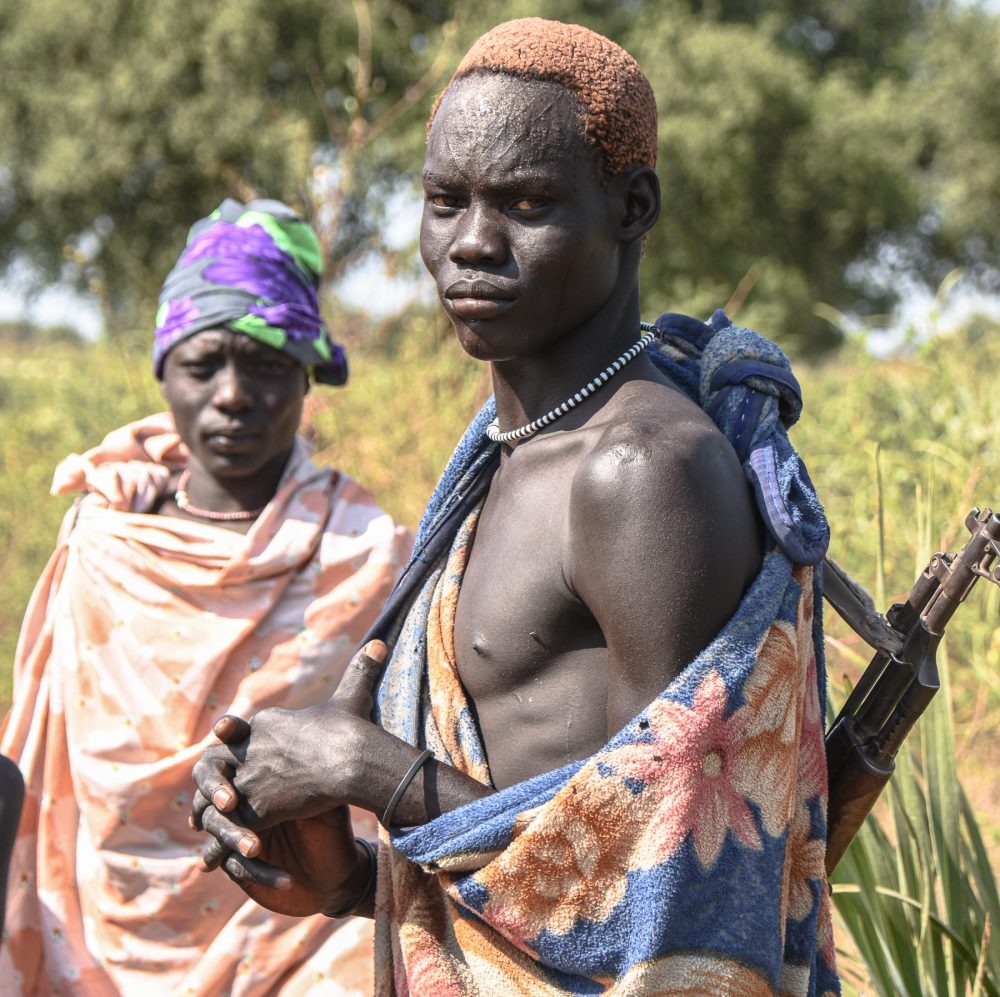
Man with gun who seemed suspicions of us
After an hour of being beaten down by the mid-day sun watching the wrestling, we started to head back to camp. We were 20 minutes away from the wrestling match when all of a sudden Mundari men started to sprint passed us in a hurry to get somewhere. We heard that a fight broke out in the match. One of the fighters accused the other of an illegal move and two clans were threatening to shoot each other. Many of the men were racing back to their huts to gather their rifles to fight the other clan. Thinking that all-out war could break out at any time, which would not end well for us, we sprinted back to our tents to pack up and get out of dodge. later on, we received word that the men returned with their guns to fight the other clan, but the other clan had already departed.
Day 4/5: At our camp we contemplated leaving in the afternoon in case the other clan decided to return and continue any fighting. But it was too late and driving back now would mean we would have to drive in the dark, which was far too dangerous. So, we departed the next morning instead on the long and rough drive back to Juba. We stayed another night in the Juba Regency Hotel. On our last day in Juba, we took a boat trip down the Nile to visit an island with a restaurant that was closed when we arrived. Along the way we saw some interesting, capsized boats.
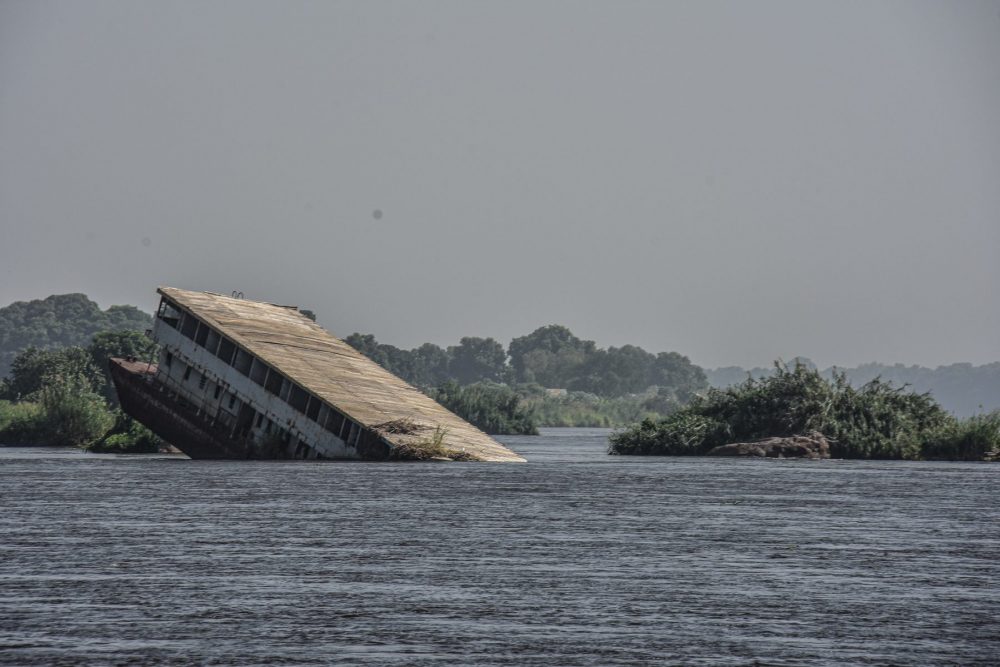
Capsized boat on Nile
Upon our departure, the airport was chaotic. We didn’t have any issues with bribes while leaving Juba at the airport, but we were forced to pay an extra 100 USD to finally receive our mandatory police registration in Juba. This was purely a required bribe. At the airport there were no other tourists. Instead, most of the passengers were non-government agency aid workers, missionaries, and United Nations workers. The departure lounge was a tent and for seats cinder blocks with slabs of wood on top for seats.
Closing Thoughts
Staying with the Mundari was an authentic and un-contrived experience at a time before they were on the main tourist circuit for South Sudan. They didn’t know we were coming, and they did little to alter their daily routine because we were there. No one dressed up for the camera or asked for money. We presented a donation to the chief of the clan we stayed with to assist with the construction of new water wells. Other than this, no payments were given to the tribe. We shared some of our food and handed out polaroid photos to children. In 2017. when I visited this is the way things were but in my experience as more tourists visit tribal cultures, the experience becomes more commercialized and less real. This will likely be the trend with the Mundari too, but South Sudan is a huge country with many more unique and remote tribes, most having little to no contact with the outside world. So, I imagine the country as it opens and eventually becomes safer, will draw in more adventure tourists seeking authentic tribal culture. This desire to see a world that is so rapidly disappearing in the modern era, will lure travelers to South Sudan despite the risks, for many years to come.
